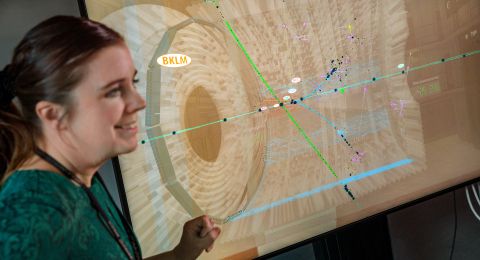
Project Grant 2012
Spin dynamics and magnonics
Principal investigator:
Olle Eriksson, Professor of Theoretical Magnetism
Co-investigators:
Uppsala University
Björgvin Hjörvarsson
Olof Karis
Peter Svedlindh
University of Gothenburg
Johan Åkerman
Institution:
Uppsala University
Grant in SEK:
SEK 37.4 million over five years
The basis for the research project is the deeper knowledge of magnetic materials that has been built up over a few years at the Ångström laboratory at Uppsala University. Olle Eriksson is a Professor of Theoretical Magnetism and the principal investigator for the project.
“We have made some progress since we've worked with exciting issues at a theoretical level. Thanks to the grant from the Knut and Alice Wallenberg Foundation, now we can also build up an experimental environment around magnetization dynamics where we hope to be able to verify our theories,” he says.
It is a matter of curiosity-driven research where an important aim is to increase the understanding of magnetic materials and put Sweden on the world map in the research field. The material can be seen as a collection of atom-sized magnets that align themselves in certain directions. But what happens if the atoms are forced out of balance is largely unknown.
“Our theoretical work predicts several interesting phenomena, especially for magnets at the nanoscale, and we would therefore gladly see how our knowledge can be converted into technical applications,” says Olle Eriksson.

New magnetic memory
Of all digital information, 80 percent is already stored on magnetic material, and the constant demand to be able to store more information on smaller devices as quickly as possible means that it is of significance to be able to identify new useful magnetic materials. With nanotechnology, it may also be possible to learn to customize materials with entirely new properties on the long term.
Among many aspirations, the researchers want to develop magnetic memory that can revolutionize computer performance. It paves the way for a development of the next generation of spintronics and a new area that has been named magnonics. In brief, the objective is to very quickly succeed in changing the magnetic direction in magnetic materials.
As soon as we write on the computer, feverish activity takes place under the hood. A computer stores information in the form of ones and zeros - in reality, this is controlled by a current of electrons that can be turned off and on in an organized way. To do this, a magnetic state of the electrons called spin is used. This spin is a measurable property that is reminiscent of the effect of a rotating magnet. The rotation, or spin, can take place in one direction or another, which means that it can be used to represent ones and zeros.
Olof Karis uses a poetic comparison.
“The spin can be compared to seaweed at the bottom of the ocean that sways one way or another. It can bend very slowly and very fast. We want it to move even faster by sending a spin-polarized current that consists of a single spin direction into a material, where spin waves can be generated.”
The question is what happens if the frequency is dramatically increased of how the seaweed bends, i.e. the number of times per second that a one becomes a zero.
“It is there that the potential to store information even more effectively lies. We envision electronics that will be able to work at a frequency that is a thousand times faster than today. Nobody else has achieved this yet.”
On today's laptops, the processor capacity is 2-3 gigahertz, which means a few billion oscillations per second. With the new level, the computers would instead have a capacity in terahertz with an ability to be able to switch from one to zero trillions of times a second.

Breaks the known laws of physics
In theoretical models and computer simulations, the researchers have already studied the effects on materials at this frequency, and even faster. The results have incited attention the world over and inspire optimism for the experimental studies.
"But there is a long way to go. To get there, we have to design new materials, make advanced measurements and learn to understand new things that might break the known laws of physics," says Olle Eriksson.
For Björgvin Hjörvarsson, the excitement lies in the fact that the research may lead to completely unexpected findings. At the nano level, the material's properties are changed to the unforeseeable.
“A glass of water freezes at 0 degrees. It turns into ice. But when does an atomic layer of water freeze? We don't know. The dynamics of the material depend a great deal on the scale, and as a design parameter, it is the scale that is unique with nanomagnetism. To be able to measure it, we have to learn to look at relevant time scales, from femtoseconds up to a few hundred nanoseconds. This will provide understanding and then we can also begin thinking about applications.”
When electricity was new in the 19th century, nobody could imagine how it would literally revolutionize modern society. It may be the same thing with magnonics, say the researchers in the project.
“If you can't afford to make mistakes, you won't be able to make progress either. The grant from the Foundation gives us the freedom to develop a new field with huge potential,” says Björgvin Hjörvarsson.
Text Nils Johan Tjärnlund
Translation Semantix
Photo Magnus Bergström



